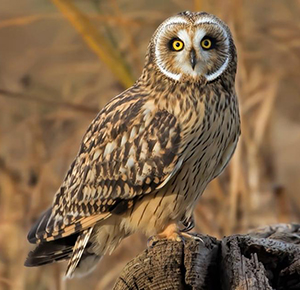UWs Biodiversity Institute Seeks Community Scientists for Short-Eared Owl Surveys This Spring
Published January 22, 2020

Hoot. Hoot. The short-eared owl needs you.
The University of Wyoming’s Biodiversity Institute is seeking volunteers to participate in short-eared owl surveys throughout the state this spring. Information gathered by the project is needed by conservation practitioners who may design management actions to help reverse the short-eared owl population decline.
The Wyoming surveys for lower-elevation grids are scheduled March 10-31 and April 1-22. Surveys for mid-elevation grids are scheduled March 24-April 14 and April 15-May 6, and surveys for high-elevation grids are scheduled April 7-28 and April 29-May 20.
“The surveys are scheduled to coincide with short-eared owl courtship displays. The males spiral up into the air, make short rapid hoots while hovering, and dive while clapping the wings together loudly under their bodies,” says Mason Lee, senior project coordinator for UW’s Biodiversity Institute. “If the birds are not seen, they may be identified by the sounds that they make. All identification information is covered during the video training and via an identification guide available online.”
The short-eared owl is an open-country, ground-nesting species found in marshes, grasslands, shrub lands and tundra. The bird is listed as a “species of greatest conservation need” in Wyoming. According to the Wyoming Game and Fish Department, the species is found in low numbers across the state, but can vary in abundance depending upon prey and spring weather conditions. Their distribution across the state is patchy and irregular.
Lee says there are 53 grids in Wyoming that need to be surveyed. Seventeen of those grids around the state still need to be filled with volunteers. Additionally, he says some of the volunteers already signed up may not be able to fulfill their requirement to the project, meaning other volunteers who can step in and finish surveys on those grids will be needed.
In 2019, the short-eared owl was detected on four grids around the state, which were different from the four grids where the bird was detected in Wyoming during 2018.
“This is because the short-eared owl is a nomadic species that may be absent from some areas for years,” Lee explains.
Traditional survey data has indicated that the owls’ populations have declined by more than 60 percent nationally in the last 40 years. The National Audubon Climate Initiative has rated the short-eared owl as “climate endangered.” The species also is identified as a “species of conservation concern” in several states.
“This is a suggested magnitude of decline, but the cause and exact magnitude of the decline is not well understood,” Lee says. “The short-eared owl has a climate association that puts it at future risk; it prefers landscapes with higher relative precipitation and moderate seasonality. Most climate scenarios expect drier summers, which will further decrease the population of this species.”
This is the sixth year of the survey program, which is under the auspices of the Western Asio flammeus Landscape Study (WAfLS), which is currently seeking Wyoming volunteers to help complete an eight-state community science project designed to gather information to better evaluate the population status of the short-eared owl. In addition to Wyoming, California, Idaho, Montana, Nevada, Oregon, Utah and Washington participate in the survey.
Wyoming joined the program in 2016 under the direction of the Teton Raptor Center. The Biodiversity Institute became involved a year later, Lee says.
Information and the training videos can be found on the project website at www.avianknowledgenorthwest.net/citizen-science/short-eared-owls.
For more information on how to get involved in Wyoming, email Lee at mlee37@uwyo.edu.

